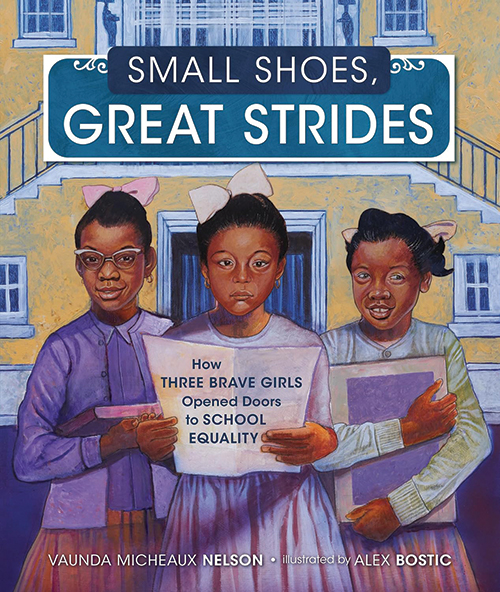
Small Shoes, Great Strides: How Three Brave Girls Opened Doors to School Equality
Reviewed by Jerry Mizell Williams
May 1, 2024
By Vaunda Micheaux Nelson, illustrated by Alex Bostic. Carolrhoda Books, 2023. 40 pages. $19.99/hardcover; $9.99/eBook. Recommended for ages 7–11.
Against the backdrop of the resounding 1954 Supreme Court ruling that found segregation in public schools to be unconstitutional, three first-grade Black girls integrated McDonogh 19 Public School in New Orleans on November 14, 1960. What is less well-known is that not only are Gail Etienne, Tessie Prevost, and Leona Tate the first to cross the school color line in Louisiana since it enacted segregation laws in 1877, but they also preceded by ten minutes the iconic entrance of Ruby Bridges into William Frantz Elementary School in the same city. Although their initial school year occasioned a mass exodus as White parents in protest withdrew their children, the three—in virtual isolation—bonded under the watchful eyes of their teacher and the U.S. Marshals who escorted them daily. Their moral and academic education commenced behind brown paper bag-covered windows that shielded them from public view for much of second grade.
The children’s story is part and parcel of the history of unrest, violence, and the psychological and emotional upheaval in their lives and in that of their respective families during the early to middle period of the Civil Rights Movement. Legal challenges mounted at the state level and by local school boards created obstacles to the implementation of the court order. They employed tactics that included academic tests that were designed to thwart the admission of Black children.
The book highlights differing degrees of the children’s initial awareness of the impact their presence in school makes locally, nationally, and internationally, and it follows their story as they work through the significance of their actions. The author, Vaunda Micheaux Nelson, is at her best when she is documenting the courage and acts of kindness the “sisters for life” bestow upon one another as they navigate an adult world where hatred and bigotry hold sway. Teachers, librarians, and the target audience of ages seven through eleven will find the last pages show the children’s lives in third grade at the integrated Thomas J. Semmes Elementary, which occurs without the protection of marshals.
The text contains a thoughtful explanation of school desegregation as practiced by the school board, as well as a decoding of Norman Rockwell’s famous painting The Problem We All Live With, which depicts a Black girl in a white dress being escorted to school by U.S. Marshals. Most insightful are the author’s updates on the McDonogh Three, a glossary of useful terms, and amply captioned photographs from the period. Moving illustrations by Alex Bostic that speak to several of our Friends testimonies brought them vividly to life for this reader.
Jerry Mizell Williams is a member of Green Street Meeting in Philadelphia, Pa. He is the author of numerous books, articles, and book reviews about colonial Latin America.



Comments on Friendsjournal.org may be used in the Forum of the print magazine and may be edited for length and clarity.